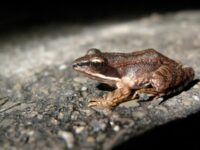Invisibility — a superpower that once only seemed possible in the Harry Potter universe — is actually more realistic than we think. A special organism found in South American rainforests, aptly named the glass frog, is a virtually transparent amphibian with translucent green skin, muscle, and tissues. Only the frog’s major organs are visible when asleep, allowing it to peacefully rest on tree leaves with little fear of predation. The frogs achieve this incredible form of camouflage by packing red blood cells into their livers, which is both a fascinating biological adaptation and a valuable avenue for research into fatal blood clot prevention.
Translucence is rare in organisms that live on land since their bodies have many essential substances that absorb light, making them visible. One important example is hemoglobin, a protein found in red blood cells that delivers oxygen around the body. Even though the glass frogs’ tissues are transparent, the hemoglobin they contain is not. Thus, when glass frogs are active, their blood vessels are visible since light can’t pass through the hemoglobin within them. However, their red blood cells seem to magically vanish when they’re asleep, rendering them translucent when at their most vulnerable.
“Studying glass frogs can produce important results about hemodynamics and how to prevent blood clot formation in the human body.”
Researchers at Duke University sought to understand exactly where these red blood cells go when the frogs are at rest. They used photoacoustic microscopy, a noninvasive technique that converts absorbed light energy into ultrasonic waves, allowing for deep, high-resolution, and high-speed imaging of biological tissue. This technique is especially useful for imaging through opaque organs and capturing spatial hemodynamics without disrupting the frog’s circulation.
“A special organism found in South American rainforests, aptly named the glass frog, is a virtually transparent amphibian with translucent skin, muscle, and tissues.”
Using this imaging, the researchers found that sleeping frogs circulate very little hemoglobin — a whopping 89% of the frogs’ red blood cells aggregate in their livers. However, hemoglobin flow quickly increases as they wake and become active since their cells require more oxygen. It only takes seconds after beginning exercise for the frogs to lose much of their transparency due to an increased presence of hemoglobin. Overall, the study shows that the density of red blood cells in circulating plasma accurately predicts the level of transparency in glass frogs. Scientists hypothesize that the frogs display decreased metabolic activity or non-oxidative metabolic processes (those not requiring oxygen) in order to compensate for decreased hemoglobin in circulation.
The glass frog’s strategy is a clever one that defies expectations. Typically, when blood cells collect, they coagulate to form a clot. This can become a scab to heal a wound, or if inside a blood vessel, can block the circulatory system and be fatal. Unfortunately, about 100,000 people in the United States suffer deadly blood clots each year, according to the CDC. Shockingly, glass frogs avoid this complication. They can control when their blood clots, so they’re able to prevent serious blockages but can still form scabs when wounded.
Studying glass frogs can produce important results about hemodynamics and how to prevent blood clot formation in the human body. The frogs pack and unpack a high concentration of their red blood cells every day without dangerous clotting events. This is likely due to a combination of biochemical factors and physical changes and remains an active avenue for research. One possibility is a method called clot contraction, which restores blood flow by decreasing the area blocked by coagulated blood. Luckily, glass frogs are a fantastic species for live animal research, since natural hemodynamic processes can be observed without restraining the organism or using contrast agents to help with imaging.
When it comes to glass frogs, one thing is clear — they are an invaluable species with the potential to greatly improve human health outcomes. By studying these masters of invisibility and how they dynamically change their red blood cell concentrations, scientists can determine ways to avoid deadly blood clots in humans and develop new anticoagulant drugs, saving countless lives.
Image courtesy of Wikimedia Commons



